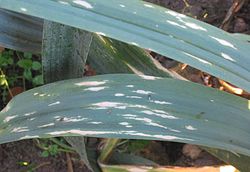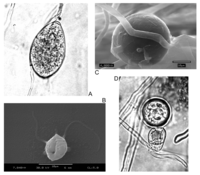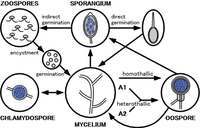Phytophthora: Perbedaan antara revisi
Kembangraps (bicara | kontrib) kTidak ada ringkasan suntingan |
Kembangraps (bicara | kontrib) k →Biologi |
||
| Baris 18: | Baris 18: | ||
==Biologi== |
==Biologi== |
||
[[Image:Phytophtora reproduction.png|thumb| |
[[Image:Phytophtora reproduction.png|thumb|left|200px|Phytophthora forms: A: Sporangia. B: Zoospore. C: Chlamydospore. D: Oospore.]] |
||
''Phytophthora'' dapat bereproduksi secara seksual maupun aseksual. Struktur reproduksi seksual jarang ditemukan di alam, tetapi dapat dirangsang di pembiakan laboratorium. Pada jenis-jenis yang ''homotalus'', struktur seksual muncul dalam satu kultur tunggal; jenis-jenis yang heterotalus memiliki dua "jenis kelamin": A1 dan A2. <!-- When mated, [[Antheridium|antheridia]] introduce gametes into [[Oogonium|oogonia]], either by the oogonium passing through the antheridium (amphigyny) or by the antheridium attaching to the proximal (lower) half of the oogonium (paragyny), and the union producing oospores. Like animals, but not like most true Fungi, meiosis is gametic, and somatic nuclei are diploid. --> |
''Phytophthora'' dapat bereproduksi secara seksual maupun aseksual. Struktur reproduksi seksual jarang ditemukan di alam, tetapi dapat dirangsang di pembiakan laboratorium. Pada jenis-jenis yang ''homotalus'', struktur seksual muncul dalam satu kultur tunggal; jenis-jenis yang heterotalus memiliki dua "jenis kelamin": A1 dan A2. <!-- When mated, [[Antheridium|antheridia]] introduce gametes into [[Oogonium|oogonia]], either by the oogonium passing through the antheridium (amphigyny) or by the antheridium attaching to the proximal (lower) half of the oogonium (paragyny), and the union producing oospores. Like animals, but not like most true Fungi, meiosis is gametic, and somatic nuclei are diploid. --> |
||
[[Image:Phytophthora_life_cycle.png|200px|The life cycle of ''Phytophthora'']] |
[[Image:Phytophthora_life_cycle.png|200px|The life cycle of ''Phytophthora'']] |
||
Revisi per 2 Maret 2012 15.05
| Phytophthora | |
|---|---|

| |
| Phytophthora porri on leek (Allium porrum) | |
| Klasifikasi ilmiah | |
| Domain: | |
| Kerajaan: | |
| Filum: | |
| Kelas: | |
| Ordo: | |
| Famili: | |
| Genus: | Phytophthora
|
| Spesies | |
|
lihat teks | |

Phytophthora (dari bentukan bahasa Yunani φυτόν (phytón), “tumbuhan” dan φθορά (phthorá), “kehancuran”; “penghancur tumbuhan”) adalah salah satu marga Oomycetes yang anggota-anggotanya banyak menjadi penyebab penyakit tanaman penting sehingga meinmbulkan kerugian ekonomi, ekologi, dan demografi yang besar. The genus was first described by Heinrich Anton de Bary in 1875. Diperkirakan ada sekitar 100 anggotanya yang telah dipertelakan, meskipun ada kemungkinan anggotanya lebih daripada itu[1].
Biologi

Phytophthora dapat bereproduksi secara seksual maupun aseksual. Struktur reproduksi seksual jarang ditemukan di alam, tetapi dapat dirangsang di pembiakan laboratorium. Pada jenis-jenis yang homotalus, struktur seksual muncul dalam satu kultur tunggal; jenis-jenis yang heterotalus memiliki dua "jenis kelamin": A1 dan A2.
 Spora aseksual (terbentuk secara mitosis) dikenal sebagai klamidospora dan zoospora. Jenis spora yang terakhir dihasilkan dalam sporangium (jamak: sporangia).
Spora aseksual (terbentuk secara mitosis) dikenal sebagai klamidospora dan zoospora. Jenis spora yang terakhir dihasilkan dalam sporangium (jamak: sporangia).
}}</ref>
- Phytophthora palmivora - causes fruit rot in coconuts and betel nuts
- Phytophthora ramorum – infects over 60 plant genera and over 100 host species - causes Sudden Oak Death[2]
- Phytophthora quercina – causes oak death
- Phytophthora sojae - causes soybean root rot
Research beginning in the 1990s has placed some of the responsibility for European forest die-back on the activity of imported Asian Phytophthoras.[3]
Fungi resemblance
Phytophthora is sometimes referred to as a fungal-like organism but it is classified under a different kingdom altogether: Chromalveolata (formerly Stramenopila and previously Chromista). This is a good example of convergent evolution: Phytophthora is morphologically very similar to true fungi yet its evolutionary history is quite distinct. In contrast to fungi, stramenopiles are more closely related to plants than animals. Whereas fungal cell walls are made primarily of chitin, stramenopile cell walls are constructed mostly of cellulose. Ploidy levels are different between these two groups; Phytophthora have diploid (paired) chromosomes in the vegetative (growing, non-reproductive) stage of life, Fungi are almost always haploid in this state. Biochemical pathways also differ, notably the highly conserved Lysine synthesis path.
-->
Spesies
Phytophthora boehmeriae
Phytophthora botryosa
Phytophthora brassicae
Phytophthora cactorum
Phytophthora cajani
Phytophthora cambivora
Phytophthora capsici
Phytophthora cinnamomi
Phytophthora citricola
Phytophthora citrophthora
Phytophthora clandestina
Phytophthora colocasiae
Phytophthora cryptogea
Phytophthora drechsleri
Phytophthora erythroseptica
Phytophthora fragariae
Phytophthora fragariae var. rubi
P. gemini
Phytophthora glovera
Phytophthora gonapodyides
Phytophthora heveae
Phytophthora hibernalis
Phytophthora humicola
Phytophthora hydropathica[4]
Phytophthora irrigata[4]
Phytophthora idaei
Phytophthora ilicis
Phytophthora infestans
Phytophthora inflata
Phytophthora iranica
Phytophthora katsurae
Phytophthora lateralis
Phytophthora medicaginis
Phytophthora megakarya
Phytophthora megasperma
Phytophthora melonis
Phytophthora mirabilis
Phytophthora multivesiculata
Phytophthora nemorosa[5]
Phytophthora nicotianae
Phytophthora palmivora
Phytophthora phaseoli
Phytophthora pini
Phytophthora porri
Phytophthora plurivora
Phytophthora primulae
Phytophthora pseudosyringae
Phytophthora pseudotsugae
Phytophthora quercina
Phytophthora ramorum
Phytophthora sinensis
Phytophthora sojae
Phytophthora syringae
Phytophthora tentaculata
Phytophthora trifolii
Phytophthora vignae
Rujukan
- ^ Brasier CM, 2009. Phytophthora biodiversity: how many Phytophthora species are there? In: Goheen EM, Frankel SJ, eds. Phytophthoras in Forests and Natural Ecosystems. Albany, CA, USA: USDA Forest Service: General Technical Report PSW-GTR-221, 101–15
- ^ "APHIS List of Regulated Hosts and Plants Associated with Phytophthora ramorum" U.S. Animal and Plant Health Inspection Services;
- ^ "Phytophthora: Asiatischer Pilz lässt die Bäume sterben" Süddeutschen Zeitung 11 May 2005
- ^ a b Hong, C (June 2008). "Phytophthora irrigata and Phytophthora hydropathica, two new species from irrigation water at ornamental plant nurseries". Phytopathology Vol. 98, no. 6. Diakses tanggal 2009-06-05.
- ^ Hansen, Everett M.; Reeser, P. W.; Davidson, J. M.; Garbelotto, Matteo; Ivors, K.; Douhan, L.; and Rizzo, David M. (2003) "Phytophthora nemorosa, a new species causing cankers and leaf blight of forest trees in California and Oregon, U.S.A Mycotaxon 88: pp. 129-138
Bacaan tambahan
- Lucas, J.A. et al. (eds.) (1991) Phytophthora based on a symposium held at Trinity College, Dublin, Ireland September 1989. British Mycological Society, Cambridge University Press, Cambridge, UK, ISBN 0-521-40080-5 ;
- Erwin, Donald C. and Ribeiro, Olaf K. (1966) Phytophthora Diseases Worldwide American Phytopathological Society Press, St. Paul, Minnesota, ISBN 0-89054-212-0
- Erwin, Donald C. (1983) Phytophthora: its biology, taxonomy, ecology, and pathology American Phytopathological Society Press, St. Paul, Minnesota, ISBN 0-89054-050-0
- "APHIS List of Regulated Hosts and Plants Associated with Phytophthora ramorum" U.S. Animal and Plant Health Inspection Services
- "Dieback" Department of Environment and Conservation, Western Australia
Pranala luar
- Goodwin, Stephen B. (January 2001) "Phytophthora Bibliography" Purdue University
- Abbey, Tim (2005) "Phytophthora Dieback and Root Rot" College of Agriculture and Natural Resources, University of Connecticut
- "Phytophthora Canker - Identification, Biology and Management" Bartlett Tree Experts Online Resource Library
- "Phytophthora Root Rot - Identification, Biology and Management" Bartlett Tree Experts Online Resource Library
- Dieback Working Group - Western Australia
